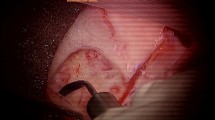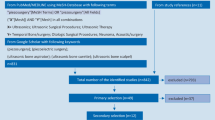Abstract
Piezosurgery® is a recently developed system for cutting bone with microvibrations. The objectives of the present study were to report our experience with the piezoelectric device in the intact canal mastoidectomy, and to compare the results with traditional method by means of microdrill. A non-randomized controlled trial was undertaken on 60 intact canal wall mastoidectomy performed using the piezoelectric device (30 patients) or the microdrill (30 patients). Before 1 month and 1 year after surgery, all the patients underwent the following instrumental examinations: otomicroscopic evaluation of the tympanic membrane and external auditory duct, bone conduction threshold audiometry, tympanometry, transient-evoked otoacoustic emissions with linear click emission, distortion product otoacoustic emissions, auditory brainstem response (ABR) by MK 12-ABR screener with natus-ALGO2e (Amplifon, Milan, Italy), and electronystamographic recording. The piezoelectric device is proved to be effective in sclerotic and pneumatic mastoid, with an excellent control and without side effects on the adjacent structures of the middle and inner ear (lateral sinus, facial nerve, and/or dura mater). The operation time has been the same as compared with microdrill, and the average hospital stay was significantly (p < 0.05) shorter. Postoperatively, all patients had uneventful recovery with no evidence of audiovestibular deficit or side effects. Our experience highlights the safety of the piezoelectric device on the anatomic structures of the middle and inner ear, and demonstrates its efficiency in terms of cutting precision and healing process.





Similar content being viewed by others
References
Bennett M, Warren F, Haynes D (2006) Indications and technique in mastoidectomy. Otolaryngol Clin North Am 39:1095–1113
Salami A, Dellepiane M, Salzano FA, Mora R (2007) Piezosurgery® in the excision of middle ear tumours: effects on mineralized and non-mineralized tissues. Med Sci Monit 13:PI 25–PI 29
Vercellotti T, Dellepiane M, Mora R, Salami A (2007) Piezoelectric bone surgery in otosclerosis. Acta Otolaryngol 127:932–937
Salami A, Verecellotti T, Mora R, Dellepiane M (2007) Piezoelectric bone surgery in otologic surgery. Otolaryngol Head Neck Surg 136:484–485
Salami A, Dellepiane M, Mora R (2008) A novel approach to the facial nerve decompression: use of Piezosurgery®. Acta Otolaryngol 128:530–533
Salami A, Mora R, Dellepiane M (2008) Piezosurgery in the exeresis of glomus tympanicum tumours. Eur Arch Otorhinolaringol 265:1035–1038
Salami A, Dellepiane M, Proto E, Mora R (2009) Piezosurgery in otologic surgery: four years of experience. Otolaryngol Head Neck Surg 140:412–418
Cho Y-S, Hong DS, Chung KW, Hong SH, Chung W-H, Shin HP (2010) Revision surgery for chronic otitis media: characteristics and outcomes in comparison with primary surgery. Auris Nasus Larynx 37:18–22
Kanemaru S, Nakamura T, Omori K (2004) Regeneration of mastoid air cells: clinical applications. Acta Otolaryngol Suppl 551:80–84
Chapple IL, Walmsley AD, Saxby MS, Moscrop H (1995) Effect of instrument power setting during ultrasonic scaling upon treatment outcome. J Periodontol 66:756–760
Lazo-Sáenz JG, Galván-Aguilera AA, Martínez-Ordaz VA, Velasco-Rodriguez VM, Nieves-Renteria A, Rincon-Castaneda C (2005) Eustachian tube dysfunction in allergic rhinitis. Otolaryngol Head Neck Surg 132:626–629
Salami A, Dellepiane M, Crippa B, Ralli G, Mora R (2009) The effects of Piezosurgery® on the cochlear outer hair cells. Acta Laryngol 129:497–500
Lenhardt ML (2003) Ultrasonic hearing in humans: applications for tinnitus treatment. Int Tinnitus J 9:69–75
Conflict of interest statement
None of the authors have a financial relationship with any organization that sponsored the research.
Author information
Authors and Affiliations
Corresponding author
Rights and permissions
About this article
Cite this article
Salami, A., Mora, R., Dellepiane, M. et al. Piezosurgery® versus microdrill in intact canal wall mastoidectomy. Eur Arch Otorhinolaryngol 267, 1705–1711 (2010). https://doi.org/10.1007/s00405-010-1308-x
Received:
Accepted:
Published:
Issue Date:
DOI: https://doi.org/10.1007/s00405-010-1308-x




